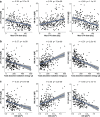Dose-dependence of radiotherapy-induced changes in serum levels of choline-containing phospholipids; the importance of lower doses delivered to large volumes of normal tissues
- PMID: 34185114
- PMCID: PMC8458179
- DOI: 10.1007/s00066-021-01802-4
Dose-dependence of radiotherapy-induced changes in serum levels of choline-containing phospholipids; the importance of lower doses delivered to large volumes of normal tissues
Abstract
Background: Conformal radiotherapy is a primary treatment in head and neck cancer, which putative adverse effects depend on relatively low doses of radiation delivered to increased volumes of normal tissues. Systemic effects of such treatment include radiation-induced changes in serum lipid profile, yet dose- and volume-dependence of these changes remain to be established.
Methods: Here we analyzed levels of choline-containing phospholipids in serum samples collected consecutively during the radiotherapy used as the only treatment modality. The liquid chromatography-mass spectrometry (LC-MS) approach applied in the study enabled the detection and quantitation of 151 phospholipids, including (lyso)phosphatidylcholines and sphingomyelins.
Results: No statistically significant differences were found in the pretreatment samples from patients with different locations and stages of cancer. To compensate for potential differences between schemes of radiotherapy, the biologically effective doses were calculated and used in the search of correlations with specific lipid levels. We found that the levels of several phospholipids depended on the maximum dose delivered to the gross tumor volume and total radiation energy absorbed by the patient's body. Increased doses correlated with increased levels of sphingomyelins and reduced levels of phosphatidylcholines. Furthermore, we observed several phospholipids whose serum levels correlated with the degree of acute radiation toxicity.
Conclusion: Noteworthy, serum phospholipid levels were associated mainly with volumes of normal tissues irradiated with relatively low doses (i.e., total accumulated dose 20 Gy), which indicated the importance of such effects on the systemic response of the patient's organism to intensity-modulated radiotherapy (IMRT).
Keywords: Head and neck cancer; Ionizing radiation; Lipidomics; Mass spectrometry; Radiation response.
© 2021. The Author(s).
Conflict of interest statement
K. Jelonek, A. Krzywon, K. Papaj, P. Polanowski, K. Szczepanik, K. Skladowski and P. Widlak declare that they have no competing interests. The funders had no role in the following: design of the study; in the collection, analyses, or interpretation of data; in the writing of the manuscript, or in the decision to publish the results.
Figures



Similar articles
-
Comparison three-dimensional conformal radiotherapy versus intensity modulated radiation therapy in local control of head and neck cancer.J Cancer Res Ther. 2018 Oct-Dec;14(6):1412-1417. doi: 10.4103/jcrt.JCRT_725_17. J Cancer Res Ther. 2018. PMID: 30488865
-
The potential for sparing of parotids and escalation of biologically effective dose with intensity-modulated radiation treatments of head and neck cancers: a treatment design study.Int J Radiat Oncol Biol Phys. 2000 Jan 1;46(1):195-205. doi: 10.1016/s0360-3016(99)00304-1. Int J Radiat Oncol Biol Phys. 2000. PMID: 10656393
-
Dosimetric comparison of three-dimensional conformal radiotherapy and intensity-modulated radiotherapy for left-sided chest wall and lymphatic irradiation.J Appl Clin Med Phys. 2019 Dec;20(12):36-44. doi: 10.1002/acm2.12757. Epub 2019 Nov 3. J Appl Clin Med Phys. 2019. PMID: 31680445 Free PMC article.
-
Dose to normal tissues outside the radiation therapy patient's treated volume: a review of different radiation therapy techniques.Health Phys. 2008 Nov;95(5):666-76. doi: 10.1097/01.HP.0000326342.47348.06. Health Phys. 2008. PMID: 18849701 Review.
-
Research progress on mechanism and dosimetry of brainstem injury induced by intensity-modulated radiotherapy, proton therapy, and heavy ion radiotherapy.Eur Radiol. 2020 Sep;30(9):5011-5020. doi: 10.1007/s00330-020-06843-4. Epub 2020 Apr 21. Eur Radiol. 2020. PMID: 32318844 Review.
Cited by
-
Low-Dose Radiation Induces Alterations in Fatty Acid and Tyrosine Metabolism in the Mouse Hippocampus: Insights from Integrated Multiomics.ACS Chem Neurosci. 2024 Sep 18;15(18):3311-3320. doi: 10.1021/acschemneuro.4c00231. Epub 2024 Aug 26. ACS Chem Neurosci. 2024. PMID: 39185768 Free PMC article.
-
The Metabolic Footprint of Systemic Effects in the Blood Caused by Radiotherapy and Inflammatory Conditions: A Systematic Review.Metabolites. 2023 Sep 9;13(9):1000. doi: 10.3390/metabo13091000. Metabolites. 2023. PMID: 37755280 Free PMC article. Review.
References
-
- Lin C, Donaldson SS, Meza JL, Anderson JR, Lyden ER, Brown CK, Morano K, Laurie F, Arndt CA, Enke CA, Breneman JC. Effect of radiotherapy techniques (IMRT vs. 3D-CRT) on outcome in patients with intermediate-risk rhabdomyosarcoma enrolled in COG D9803—a report from the Children’s Oncology Group. Int J Radiat Oncol Biol Phys. 2012;82(5):1764–1770. doi: 10.1016/j.ijrobp.2011.01.036. - DOI - PMC - PubMed
-
- Abel E, Silander E, Nyman J, Björk-Eriksson T, Hammerlid E. Long-term aspects of quality of life in head and neck cancer patients treated with intensity modulated radiation therapy: a 5-year longitudinal follow-up and comparison with a normal population cohort. Adv Radiat Oncol. 2020;5(1):101–110. doi: 10.1016/j.adro.2019.07.015. - DOI - PMC - PubMed
MeSH terms
Substances
Grants and funding
LinkOut - more resources
Full Text Sources

